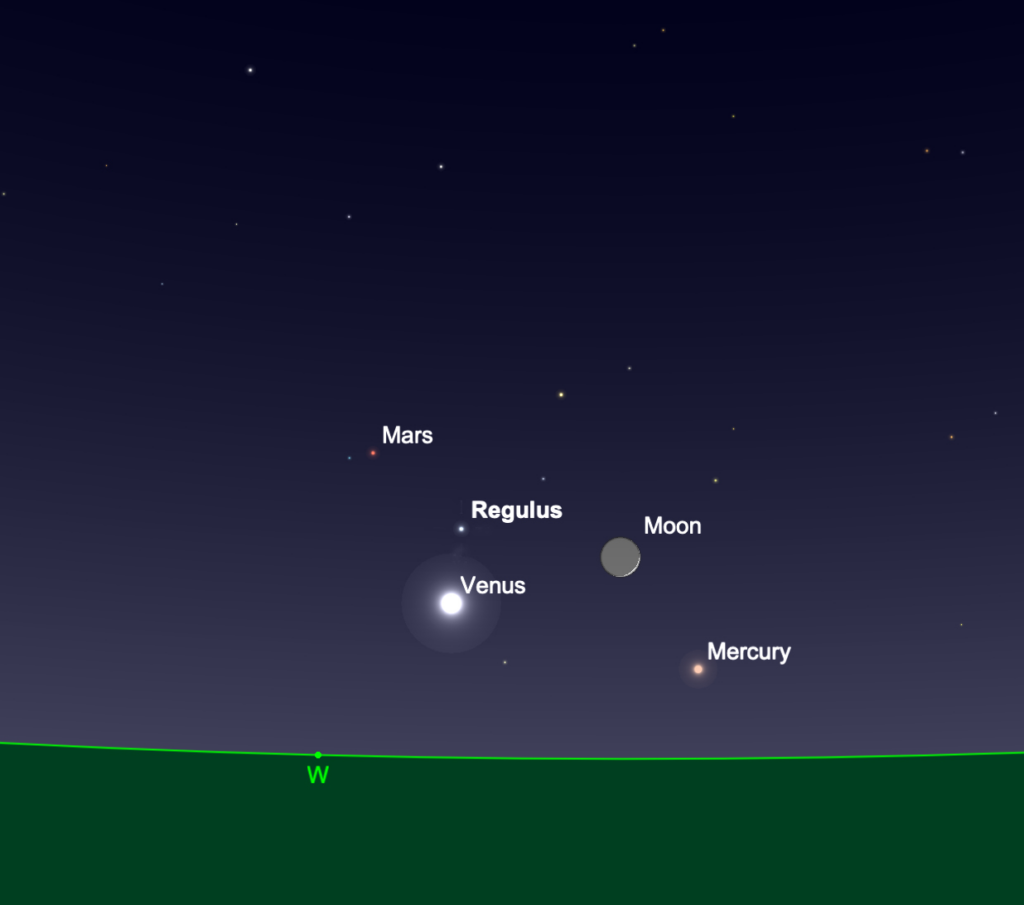Sky Report: July 17 – 23

The western sky 45 minutes after sunset on the 19th. The stars of Leo are included. Graphic created with SkySafariAstronomy.
Although we’re about to lose the evening planets they’ll go out with a bang. The night of the 19th is the best night to look, but all week they put on an interesting and ever-changing display you won’t want to miss. All you need is a low western horizon and a clear, dust-free and haze-fee sky. (And, as often, binoculars help greatly.)
On the 19th look low in the west about 45 minutes after sunset to see brilliant Venus only 7° above the horizon. Of course you can see Venus long before this, but this is about when you can also see the star Regulus, in Leo, which is almost 4° straight above Venus. Mars is 6° to the upper left of Regulus. To make it more interesting, the ultra-thin crescent moon, only 2 days after its new phase, lies 9° to the right of Venus. Mercury sits a scant 4° above the horizon, but it’s quite bright which gives you a chance to see it despite its low altitude. That’s quite a few planets, the moon, and a bright star in so small a patch of the sky.
To amplify the scene, Regulus is slightly but noticeably brighter than Mars. And Regulus is a blue-white star while Mars is an orange planet; the color difference is best seen with binoculars. The stars of Leo are above Regulus.
Venus is about to move between the earth and sun and it’s almost at its largest as seen through a telescope – and tripod mounted binoculars that are 10 power or greater. It’s a very thin crescent since the sun is lighting up mostly the back side as seen from earth.
The moon is the slimmest of crescents only 5% illuminated by the sun and no brighter than Venus. If the air is clear look for “earthshine” on the moon – sunlight reflected off the earth; the earth is virtually full as seen from the moon. Like Venus, the lit portion of the moon faces the sun and we see the dark side of the moon from earth. On the 20th the moon is less than 3° from Mars and you can see the two together in binoculars; the moon is also noticeably fuller then too.
Mercury is making an evening appearance and remains visible into next week, always low. On the 22nd it’s the same height as Venus but much fainter. Venus can guide the way to Mercury. Mercury too has phases but the planet is so small and so distant that they’re hard to see even with a decent telescope when the planet is so near the horizon (like Venus, look earlier during daylight when the planet is higher).
This is for the 19th, but look all week; there are changes night-by-night.
Saturn rises around midnight and shines with a yellowish light the rest of the night.
Jupiter rises around 2 a.m. and is brighter than anything else in the morning sky.
Stellar Vista Observatory provides portable telescopes and tripod mounted binocular kits on loan for free to residents and visitors in Kane County. Enhance your enjoyment of the night sky! To learn more, request a loan, or attend one of SVO’s free public star parties for 2023, visit https://stellarvistaobservatory.org/ or drop in to the Kane County Office of Tourism.






Comments are closed.